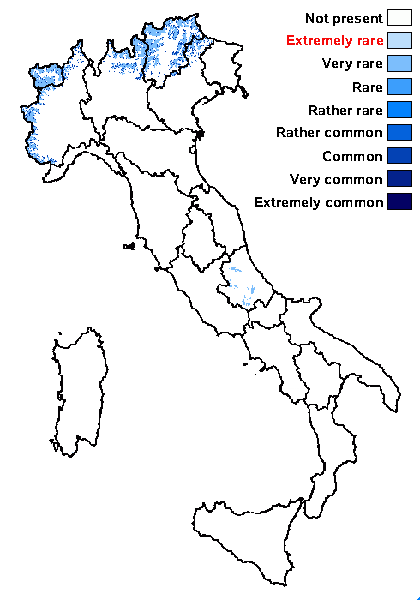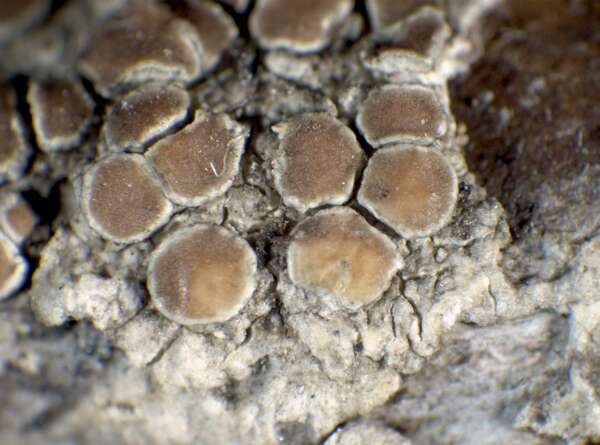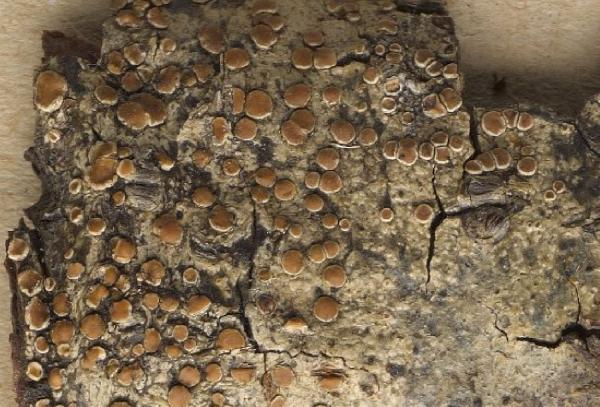Lecanora salicicola H. Magn.
Bot. Not.: 311, 1939.
Synonyms: Lecanora chlarona f. rhododendri Harm.; Lecanora migdina sensu Poelt & Vězda; Lecanora pulicaris subsp. rhododendri (Harm.) Clauzade & Cl. Roux; Lecanora subfuscata var. rhododendri Poelt
Distribution: N - Ven (Nascimbene & Caniglia 2000, 2003c, Tomaselli & al. 2006), TAA (Nascimbene & al. 2006e, 2007b, 2014, 2022, Nascimbene 2014, Nascimbene & Marini 2015, Nimis & al. 2015, Trindade & al. 2021), Lomb (Roux & Triebel 1994, Nascimbene & al. 2006e), Piem (Tretiach 1997, Griselli & al. 2003), VA (TSB 29452). C - Abr (Nimis & Tretiach 1999).
Description: Thallus crustose, thin, white to grey-white, continuous to slightly warted, epruinose, sometimes delimited by a dark prothallus. Apothecia lecanorine, 0.3-1.2 mm across, sessile or slightly constricted at base, with a pale brown, orange-brown to medium brown (rarely darker), epruinose, flat to slightly convex disc, and a thin, smooth, persistent thalline margin which tends to become much thinner with age. Thalline exciple with a 20-30 µm thick cortex inspersed with abundant, very small crystals visible under polarized light; medulla rich in algae, with small crystals (2-2.5 µm) intermixed with a few very large crystals (to 40 µm); epithecium almost colourless to grey-brown, chlarotera-type, i.e. with coarse (1-4 μm) crystals visible under polarized light, mainly located on the paraphyses tips and usually slowly soluble in N; hymenium colourless, 80-100 µm high, not inspersed with oil droplets; paraphyses 1.5-2.5 µm thick at mid-level, the apical cells swollen, 3.5-4 µm wide; hypothecium colourless, not inspersed. Asci 8-spored, clavate, very thin-walled, with a K/I+ blue, tall tholus penetrated by a faintly amyloid apical cushion, the wall K/I-, surrounded by a blue outer layer, Lecanora-type. Ascospores 1-celled, hyaline, ellipsoid, 11-17 x 5-8 µm, thin-walled. Photobiont chlorococcoid. Spot tests: thallus and apothecial margin K+ yellow, C-, KC-, P+ yellow. Chemistry: atranorin, chloratranorin, and roccellic acid. Note: a probably circumboreal-montane lichen found on dead or decaying twigs of shrubs, especially Rhododendron ferrugineum in the subalpine belt; certainly widespread throughout the Alps, much rarer in the Apennines.
Growth form: Crustose
Substrata: bark
Photobiont: green algae other than Trentepohlia
Reproductive strategy: mainly sexual
Commonnes-rarity: (info)
Alpine belt: very rare
Subalpine belt: common
Oromediterranean belt: absent
Montane belt: absent
Submediterranean belt: absent
Padanian area: absent
Humid submediterranean belt: absent
Humid mediterranean belt: absent
Dry mediterranean belt: absent

Predictive model
Herbarium samples


P.L. Nimis; Owner: Department of Life Sciences, University of Trieste
Herbarium: TSB (8250)
2001/11/25

Detail from: https://gzu.jacq.org/GZU000290842
GZU000290842 - Collector Stenholm,C. Magnusson, Lichenes selecti Scandinavici exsiccati 306a
Date 1933-07-28
Location Sweden / Jämtlands Län
Label Sweden. Jämtland: Are, Skalstugan
Habitat On branches of dying Salix
Annotations GZU Inv.-Nr. 217-80
E. Hinteregger 1988, TLC-An.Nr. E1/10: Atranorin, Roccellsäure und Stoff (7/7/7) in tr.
Growth form: Crustose
Substrata: bark
Photobiont: green algae other than Trentepohlia
Reproductive strategy: mainly sexual
Commonnes-rarity: (info)
Alpine belt: very rare
Subalpine belt: common
Oromediterranean belt: absent
Montane belt: absent
Submediterranean belt: absent
Padanian area: absent
Humid submediterranean belt: absent
Humid mediterranean belt: absent
Dry mediterranean belt: absent

Predictive model
| Herbarium samples |


P.L. Nimis; Owner: Department of Life Sciences, University of Trieste
Herbarium: TSB (8250)
2001/11/25

 INDEX FUNGORUM
INDEX FUNGORUM
 GBIF
GBIF
 DOLICHENS
DOLICHENS


